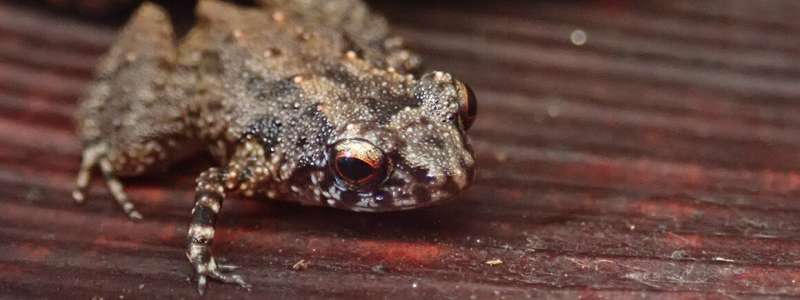Tropical frogs can adapt to climate change, but rapidly warming temperatures still pose a huge threat

An international group of researchers have found evidence of tropical frogs adapting to warming temperatures, but warn that human-induced climate change still poses a huge threat to species' survival.
An international group of researchers, including Dr. Jeff Streicher, Senior Curator in Charge, Amphibians and Reptiles at the Natural History Museum, and Dr. Jim Labisko, Lecturer in Biodiversity at University College London, have found evidence of tropical frogs adapting to warming temperatures, but warn that human-induced climate change still poses a huge threat to species' survival.
The Seychelles frog (Sooglossus sechellensis) is endemic to the islands of Mahé, Silhouette and Praslin in the Seychelles. Researchers focused on a population of Sooglossus sechellensis which—due to historic sea level rise—have been forced to inhabit the significantly warmer island of Praslin. Along with a warmer temperature, Praslin also lacks the high-elevation mist forest habitat that Sooglossus sechellensis inhabits on Mahé and Silhouette. With the population on Praslin having little to no opportunity to avoid the hotter climates, the researchers hypothesized that the population of frogs on Praslin must have adapted to survive in warmer environments than their closest living relatives and ancestors.
"Tropical amphibians exemplify the situation that faces a whole range of species due to human-induced climate change' says Dr. Streicher. "We wanted to know how and if this isolated population of frogs had adapted to a warmer climate, to try and understand how organisms will cope as the climate becomes hotter."
Tropical amphibians, particularly those that inhabit islands, are vulnerable to a warming climate due to a range of factors—they are ectothermic (their body temperature is regulated by the external environment) prone to desiccation and are often restricted to very specific areas.
Using a wide range of data that included body size, bioacoustic data and elevational distribution, the researchers were able to show that some tropical amphibians have survived episodes of historic warming and therefore may have the capacity to adapt to the currently warming climate. For example, the frogs on Praslin were living at a lower, and therefore warmer elevation, than their closest living relatives on other islands. They also had the same activity patterns as their other island counterparts despite the warmer temperatures:
"There were no apparent differences between the timings of daily vocal activity of the frogs on any of the islands, which was particularly interesting' says Dr. Labisko. "On the islands of Mahé and Silhouette different sooglossid species are each active at different times of day but there is only one species of sooglossid on Praslin, so no related competitors, and so we might have expected the Praslin frogs to shift their activity pattern to cope with the warmer temperatures and be more active at cooler periods, such as at night. However, this wasn't the case and the frogs maintained the timing of their vocal activity, even at a warmer temperature."
Despite these adaptations, the researchers, including scientists from the Seychelles Islands Foundation and Perth Zoo, warn that local extinction is still a likely outcome for tropical frogs in a rapidly warming world. The frogs on Mahé and Silhouette (the closest living relatives of the frogs on Praslin) diverged from the frogs on Praslin around 8 million years ago. Therefore, the adaptions to a warmer climate seen in the frogs on Praslin may have occurred very gradually. Genetic evidence and differences in call characters from the study also suggests that the frogs on Praslin may have even evolved into a new species.
"This population of frogs appear to have been able to adapt to a warming climate, even if this level of adaptation may have taken a long time' says Dr. Streicher. "It's exciting to think that this adaptive potential could also be present in other populations of climate-vulnerable organisms."
"With a rapidly warming climate, it's really important to understand how different species respond to climate change' says Dr. Labisko. "Our study provides evidence that vulnerable species (even little brown island frogs!) can adapt to warmer climates, but they may only be able to do so when warming is gradual and natural selection can occur over millions of years. That makes the current climate crisis a major concern as most species will not have millions of years to adapt to rapidly rising temperatures."
The study, "Survival of climate warming through niche shifts: Evidence from frogs on tropical islands," is published in Global Change Biology
More information: Jim Labisko et al, Survival of climate warming through niche shifts: Evidence from frogs on tropical islands, Global Change Biology (2021). DOI: 10.1111/gcb.15997
Journal information: Global Change Biology
Provided by Natural History Museum




















